Metric in Sports: Track and Field

Hurdles | High Jump | Long Jump | Pole Vault | Javelin
Discus | Hammer Throw | Shot Put
Measurement is integral to athletics! Metric system measurements are applied in track and field sports, including playing field, track and court dimensions, formations and distance between teammates or opponents, as well as the weight and length of sports apparatus. Competitions often occur at high school, collegiate, and international levels.
Track Events:

Track events are a major part of both international and high school games. They encompass a variety of races that test the speed, endurance and agility of athletes.
Some track events include: 100 m (sprint), 200 m, 800 m (middle distance), and relays. Sprints are also known as short-distance races. Middle-distance races range from 800 m to 2000 m. Long-distance races cover 3000 m or more. There are typically 8 competitors racing to the finish line.
Hurdles:
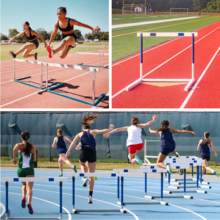
Hurdles are a staple event at both high school games, collegiate and international events. International games include 110 m men event, 100 m women event, and 400 m men and women even. The race includes 10 hurdles with a height of 107 cm for men and 84 cm for women.
Field Events:
High Jump
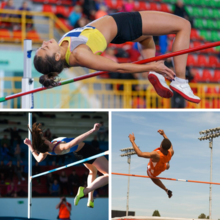
High jump is a field event in which the athlete takes a running jump to attain maximum height. In high jump, the athlete jumps from only one foot. If the athlete knocks the bar of its supports, that is considered a failed jump and if there are three failed jumps, the athlete is disqualified. The sport takes place on a level, semicircular runway allowing an approach run of at least 15 m from any angle within its 180° arc. The jumper lands in a pit beyond the bar that is at least 5 m by 3 m in size and filled with a soft, cushion-like material.
Long Jump

Long jump is a field event that aims is to cover a maximum possible distance with a horizontal jump. The entire course consists of three parts: the runway, take-off board, and the sandpit. In international competition, the runway measures about 40 m in length and it is made of a rubberized material laid over concrete. The take-off board is 20 cm wide.
Pole Vault

Pole vault is a field event in which an athlete jumps over an obstacle with the aid of a pole. Pole vaulting for height became a competitive sport in the mid-19thcentury. Originally, it was just a means of clearing objects. Pole lengths vary between 3.05 m and 5.30 m. The standard run up distance for pole vault is 40 m with a width of 1.22 m. A standard landing cushion is 5 m by 5 m with a 25 m2 area. The run-up box also has standard specifications or design of 1.084 m in length, 600 mm width at the front end and shaped to 150 mm at the bottom.
Javelin
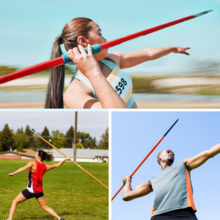
Javelin is a field event in which a long pole is thrown to cover a maximum possible distance. Men's javelins range from 2.6 m to 2.7 m in length. Women's javelins range from 2.2 m to 2.3 m. Men's javelins weigh at least 0.816 kg and women's weigh 0.589 kg. Athletes wear shoes with no more than 11 spikes. Each spike must be 12 mm long and 4 mm in diameter or smaller. The javelin field is 8 m long by 4 m wide.
Discus

Discus is a field event that uses a frisbee shaped object fixed at 2 kg for the men and 1 kg for women. The metal disc is thrown by an athlete standing in a circle with a diameter of 2.5 m. In international competitions, each athlete has eight attempts to mark their best possible throw.
Hammer Throw
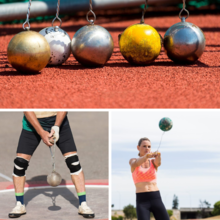
Hammer throw is a field event that makes use of a hammer, which consists of a metal ball attached to a length of wire with a handle at the top. For men, the hammer weighs about 7.26 kg and is on a wire of length 121.3 cm. For women, the hammer weighs about 4 kg and is on a wire of length 119.4 cm. In this sport, both male and female athletes make their throw from inside a ring which is 2.135 m in diameter into a sector which is 34.92 degrees from the center of the throwing ring.
Shot Put
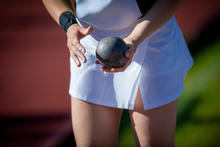
Shot put is a field event in which a spherical weight is thrown, or "put," from the shoulder for distance. It derives from the ancient sport of putting the stone. The metal ball weighs about 7.26 kg for men and 4 kg for women. The aim is to put the metal ball as far as possible from a 2.135 m diameter circle that has a curved 10 cm high toe-board at the front. Athletes throw 6 times in international competitions.
Resources
- SI Adoption in High School Athletics (US Metric Association)
- High School Rule Book (USA Track and Field)
- International Summer Games Qualifying Information (USA Track and Field)
- Maximizing Long Jump (Video, National Science Foundation and NBC Learn)
- Sports Numbers (NCTM). In this activity, students apply their knowledge and interpret how numbers are used in a variety of sports scenarios (3rd to 5th grade).
- Metric in Sports:
EXPLORE THE METRIC PROGRAM
Becoming Familiar with SI | Everyday Estimation | Metrication FAQs | Prefixes | Metric Kitchen | SI Education and Training | SI Publications | Understanding Metric | Writing with Metric Units | National Metric Week | NEST-R (STEM Registry) | NIST Education Resources
Contacts
-
Metric Program

